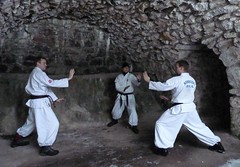Unlike in previous years, this year the traditional Pakkasleiri (Frozy Camp) was held in and around Helsinki. While this changed the usual atmosphere of living in the forest in a wooden cottage, chopping firewood and feeding it to the fire in the fireplace, and crunching through the snow to the outhouse whenever nature called, I was glad for the opportunity to stay with my other friends in Helsinki, who have no association with martial arts.
There is a fairly large, somewhat socialistic in character, but utilitarian in function, pay-to-train training hall in Töölö, its ticket machines ever hungry for precious coins. On a weekend, it is full of individuals and groups training various sports, and it takes all the discipline of a martial artist to keep one's eyes firmly on the floor ahead when a contingent of cheerleaders practices jumping up and down the stairs.
The first of the seminar's training was dedicated to defending against various attacks, where the defence involved a counter-attack or even just interception with a leg technique. As it is customary in nanbudo, the first worry is getting the head or stomach out of the way of the incoming attack. After that, the possibilities are many: mawashi geri across the solar plexus,_ mae geri_ in the ribs, ushiro mawashi geri in the face. All of these were practised at normal speed, but also in slow motion to demonstrate superior control, which turned out to be exqusitly challenging, especially in the case of ushiro mawashi. The evening concluded very satisfactorily in the nearby Thai restaurant.
On Saturday morning, we checked out a fairly new training hall in Herttoniemi, called BudoSport. The proprietor is a very eloquent man, speaking at length in slow-measured Finnish that I'd love to have recorded so I could learn from it. We had a whole dojo for ourselves. After the obligatory ukemi undo, we explored all the elements of nanbu sotai and performed the randori. Special attention was paid to staying on the same straight line throughout the exercise and on the position of the balancing hand.
After a sushi lunch, we took a ferry to Suomenlinna, the great sea-facing military structure on one of the islands south of Helsinki. The training took place under the fortified arches just inside the outer wall, in a cramped, rocky space. Nanbu nidan was dissected thoroughly, with special focus on posture and balance during the mikazuki geri and haito uchi manoeuvres. A group of American tourists came by but decided not to mess with us.
Saturday night was the pre-ordained time for researching the neighbourhood for places to socialize. Many discussions were held during this time, some more coherent than others. As a result of this outing, the Sunday trainings were rescheduled for noon rather than 10 AM.
Sunday noon saw us in a dance cubicle with a full-length mirror, practicing Seipai, a beautiful but challenging master-level kata. Even though there weren't a whole lot of us, the combined kiai would startle and scatter groups of women jogging past our cubicle. At one time, bored teenage boys would hang at the railing, pretending not to watch and secretly admire us.
It was interesting to revisit the style after a year of practising more traditional techniques. Since the underlying principles are very similar (balance, precision, responsiveness, evasion), the only marked difference evoking massive nostalgia was ki nanbu taiso, which apparently evolved somewhat during my absence.
For next year, we shall order seriously sub-zero temperatures, so we can again venture out on the ice.
Andrej Cibej, 1 kyu (shitoryu)
